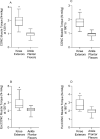Enhancement of Muscle Shortening Torque Preloaded with Muscle Lengthening is Joint-Specific
- PMID: 37229413
- PMCID: PMC10203843
- DOI: 10.5114/jhk/161729
Enhancement of Muscle Shortening Torque Preloaded with Muscle Lengthening is Joint-Specific
Abstract
Our cross-sectional study aimed to investigate joint specificity of concentric muscle torque enhancement after a maximum eccentric contraction for the knee versus ankle joints across two different movement velocities (120°/s and 180°/s). After a familiarization session, 22 healthy young adults randomly performed concentric (CONC) and maximum eccentric preloaded concentric (EccCONC) muscle strength tests of the knee extensors and ankle plantar flexors of the non-dominant leg on an isokinetic strength testing device. We calculated the ratio between EccCONC and CONC (EccCONC/CONC) for all the conditions as the marker of concentric muscle torque enhancement. Separate two-way (joints x velocity) within repeated measures ANOVAs were used to determine joint-specific torque differences at 120°/s and 180°/s. CONC and EccCONC were greater for the knee extensors versus ankle plantar flexors at 120°/s and 180°/s (32.86%-102%; p < 0.001 for both); however, EccCONC/CONC was greater for the ankle plantar flexors than knee extensors at 120°/s (52.4%; p < 0.001) and 180°/s (41.9%; p < 0.001). There was a trend of greater EccCONC/CONC for the knee extensors at 180°/s than 120°/s (6.6%; p = 0.07). Our results show that greater concentric muscle torque enhancement after a maximal eccentric contraction occurs for the ankle plantar flexors versus knee extensors. Whether the joint- specificity of concentric muscle torque enhancement after a maximal eccentric contraction differentially affects sports performance is unknown. Our data provide a reference framework to investigate joint-specific concentric muscle torque enhancement for general and clinical athletic populations.
Keywords: muscle performance; plyometric; potentiation; stretch shortening cycle.
Copyright: © Academy of Physical Education in Katowice.
Figures




References
-
- Alexander, R. M. (1984). Elastic Energy Stores in Running Vertebrates. American Zoologist, 24(1), 85–94.
-
- Blanpied, P., Levins, J. A., & Murphy, E. (1995). The effects of different stretch velocities on average force of the shortening phase in the stretch-shorten cycle. Journal of Orthopedic & Sports Physical Therapy, 21(6), 345–353. - PubMed
-
- Bobbert, M. F., & Casius, L. J. (2005). Is the effect of a countermovement on jump height due to active state development? Medicine & Science in Sports and Exercise, 37(3), 440–446. - PubMed
-
- Caserotti, P., Aagaard, P., Simonsen, E. B., & Puggaard, L. (2001). Contraction-specific differences in maximal muscle power during stretch-shortening cycle movements in elderly males and females. European Journal of Applied Physiology, 84(3), 206–212. - PubMed
Grants and funding
LinkOut - more resources
Full Text Sources
